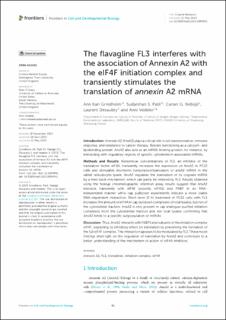| dc.contributor.author | Grindheim, Ann Kari | |
| dc.contributor.author | Patil, Sudarshan | |
| dc.contributor.author | Nebigil, Canan G. | |
| dc.contributor.author | Désaubry, Laurent | |
| dc.contributor.author | Vedeler, Anni | |
| dc.date.accessioned | 2023-06-28T06:48:43Z | |
| dc.date.available | 2023-06-28T06:48:43Z | |
| dc.date.created | 2023-06-14T17:44:40Z | |
| dc.date.issued | 2023-05-12 | |
| dc.identifier.issn | 2296-634X | |
| dc.identifier.uri | https://hdl.handle.net/11250/3073858 | |
| dc.description.abstract | Introduction: Annexin A2 (AnxA2) plays a critical role in cell transformation, immune response, and resistance to cancer therapy. Besides functioning as a calcium- and lipidbinding protein, AnxA2 also acts as an mRNA-binding protein, for instance, by interacting with regulatory regions of specific cytoskeleton-associated mRNAs.
Methods and Results: Nanomolar concentrations of FL3, an inhibitor of the translation factor eIF4A, transiently increases the expression of AnxA2 in PC12 cells and stimulates shortterm transcription/translation of anxA2 mRNA in the rabbit reticulocyte lysate. AnxA2 regulates the translation of its cognate mRNA by a feed-back mechanism, which can partly be relieved by FL3. Results obtained using the holdup chromatographic retention assay results suggest that AnxA2 interacts transiently with eIF4E (possibly eIF4G) and PABP in an RNA-independent manner while cap pulldown experiments indicate a more stable RNA-dependent interaction. Short-term (2 h) treatment of PC12 cells with FL3 increases the amount of eIF4A in cap pulldown complexes of total lysates, but not of the cytoskeletal fraction. AnxA2 is only present in cap analogue-purified initiation complexes from the cytoskeletal fraction and not total lysates confirming that AnxA2 binds to a specific subpopulation of mRNAs.
Discussion: Thus, AnxA2 interacts with PABP1 and subunits of the initiation complex eIF4F, explaining its inhibitory effect on translation by preventing the formation of the full eIF4F complex. This interaction appears to be modulated by FL3. These novel findings shed light on the regulation of translation by AnxA2 and contribute to a better understanding of the mechanism of action of eIF4A inhibitors. | en_US |
| dc.language.iso | eng | en_US |
| dc.publisher | Frontiers | en_US |
| dc.rights | Navngivelse 4.0 Internasjonal | * |
| dc.rights.uri | http://creativecommons.org/licenses/by/4.0/deed.no | * |
| dc.title | The flavagline FL3 interferes with the association of Annexin A2 with the eIF4F initiation complex and transiently stimulates the translation of annexin A2 mRNA | en_US |
| dc.type | Journal article | en_US |
| dc.type | Peer reviewed | en_US |
| dc.description.version | publishedVersion | en_US |
| dc.rights.holder | Copyright 2023 the authors | en_US |
| dc.source.articlenumber | 1094941 | en_US |
| cristin.ispublished | true | |
| cristin.fulltext | original | |
| cristin.qualitycode | 1 | |
| dc.identifier.doi | 10.3389/fcell.2023.1094941 | |
| dc.identifier.cristin | 2154617 | |
| dc.source.journal | Frontiers in Cell and Developmental Biology | en_US |
| dc.identifier.citation | Frontiers in Cell and Developmental Biology. 2023, 11, 1094941. | en_US |
| dc.source.volume | 11 | en_US |

